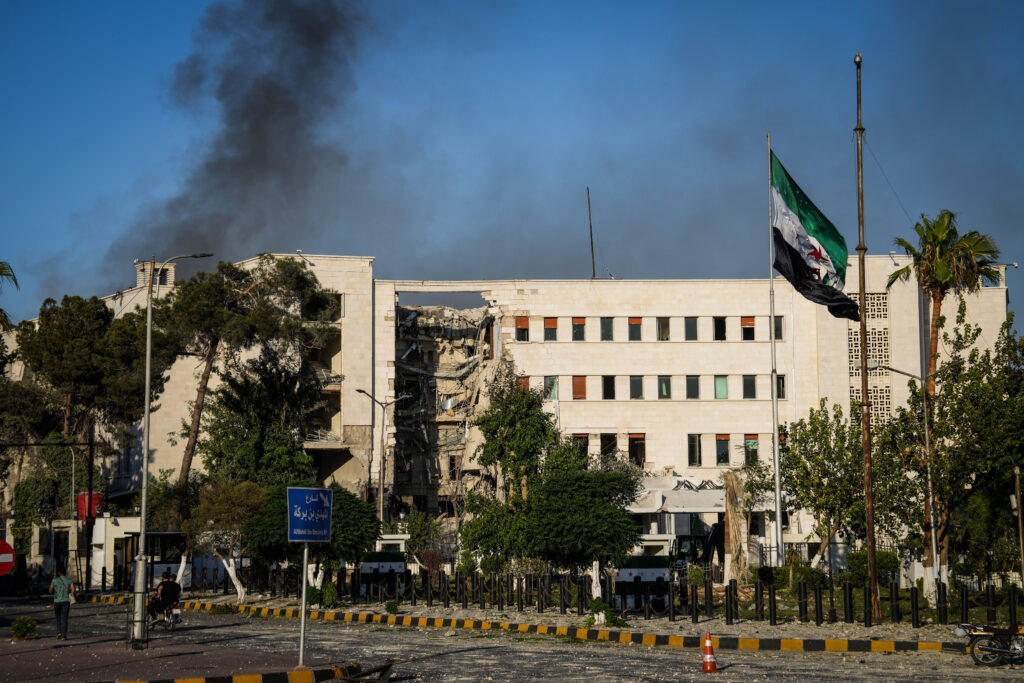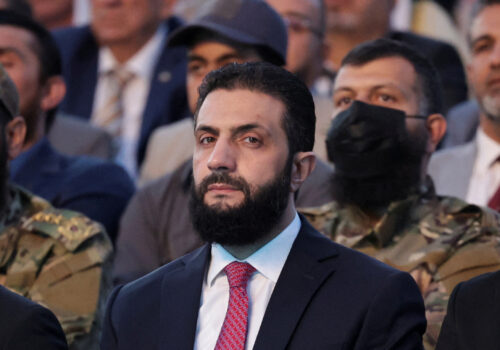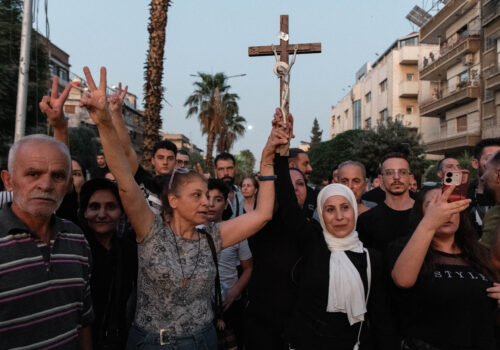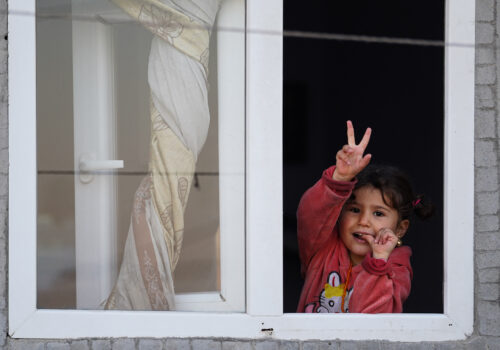“The warnings in Damascus have ended—now painful blows will come.” That’s how Israeli Defense Minister Israel Katz described Wednesday’s airstrikes on the Syrian capital, damaging the headquarters of the Syrian Defense Ministry. The bombing followed several days of clashes in the city of Sweida between Syrian security forces and members of the Druze religious minority, which Israel has said its strikes are intended to protect. Later Wednesday, the Syrian government and Druze leaders announced a tentative cease-fire, but Israel’s strikes continued. Below, our Middle East experts answer the burning questions about the roots of the crisis and what it means for Syria, Israel, the Druze, and the broader region.
1. Who are the Druze, and how did they end up in the middle of this conflict?
The Druze are a religious and ethnic minority concentrated in southern Syria, particularly in the Sweida region. Historically, they have maintained a strong communal identity and a degree of autonomy. Their relations with Damascus have long been strained, with the Druze often resisting centralized authority, whether during the French Mandate or under successive Syrian governments. Tensions between Druze militias and neighboring Sunni Bedouin tribes predate the modern Syrian state and tend to resurface during moments of national fragmentation.
During the Syrian uprising, the Druze followed a distinct path: Rather than aligning with either the regime or the opposition, they chose to protect their local communities and remain largely neutral. This autonomy has long frustrated Damascus, first under Bashar al-Assad, and now under President Ahmed al-Sharaa, who seeks to reassert state control over the south.
Following the fall of the Assad regime, Sheikh Hikmat al-Hijri, one of the most influential Druze spiritual leaders in Syria, called for international protection of the community. This marked a major shift, highlighting growing estrangement from Damascus. Yet al-Hijri is not the sole voice of the Druze. Other leaders within the community have taken different positions, with some cautioning against seeking outside protection—particularly from Israel—fearing it could deepen their isolation and jeopardize any future national consensus.
The Druze also have deep familial and political ties to communities in Lebanon and Israel, which adds a regional dimension to their situation and increases the risk of escalation beyond Syria’s borders.
—Ibrahim Al-Assil is a resident senior fellow for the Syria Project in the Atlantic Council’s Middle East Programs and a lecturer at George Washington University’s Department of Political Science.
***
The involvement of Israel, which has positioned itself as a protector of the Druze, has further complicated matters and fueled suspicion among other Syrian communities. The situation came to a head in Sweida, where violent clashes broke out with neighboring Sunni Bedouin tribes, driven by long-standing socioeconomic and sectarian tensions.
In the wake of the recent escalation, Syrian government forces intervened to quell the fighting between Druze militias and armed Arab tribal groups. Seizing the opportunity presented by the security vacuum, the state moved to reassert its control over Sweida and to push back against growing local demands for self-administration. Despite Israeli airstrikes and some international expressions of concern, the Druze community today finds itself more vulnerable than before. Government forces are poised to redeploy and partially withdraw from Sweida, which could be considered a victory for the al-Hijri clan. However, more than anytime before this point, all actors involved find themselves at a crossroads. A negotiated, peaceful resolution for reintegration with the Syrian state is urgently needed. Without such an agreement, the risk of renewed violence looms large. Any new escalation could quickly surpass the local level, engulfing other regions and threatening national cohesion and regional stability. The current fragile calm should be seen as an opportunity to pursue dialogue before another, potentially more violent, chapter unfolds.
—Sinan Hatahet is a nonresident senior fellow for the Syria Project in the Atlantic Council’s Middle East Programs and the vice president for investment and social impact at the Syrian Forum.
2. What is the Syrian government thinking right now?
From the perspective of al-Sharaa, the unrest in Sweida is both a threat and an opportunity. Damascus seeks to reassert control over a region that has long resisted its authority, leveraging historic tensions between Druze militias and Sunni Bedouin tribes to justify intervention. But Israel’s direct and escalatory involvement has complicated those calculations.
Israeli strikes have gone beyond the south, targeting army headquarters in Damascus and even near the presidential palace. The message is clear: Israel supports the Druze and is prepared to escalate disproportionately, reshaping its posture in Syria. Damascus now realizes that improved ties with Washington do not guarantee détente with Israel. It also fears a broader regional flare-up that could bring in other regional actors such as Turkey.
Still, the al-Sharaa government believes time and force are on its side. It expects local cease-fires, even if short-lived, to emerge from negotiations with community leaders, gradually wearing down resistance. But the widespread violations and selective disarmament demands, which are targeting only Druze and not Bedouin tribes, are fueling mistrust and reinforcing perceptions that Damascus has chosen domination over reconciliation.
Ultimately, the Sweida crisis exposes the risks of managing Syria’s transition through coercion rather than consensus. This is especially the case given the many potential spoilers in the region and with Israel poised to exploit instability to undercut Damascus’s efforts at national consolidation. Al-Sharaa knows that he is entering uncharted territory, and he will have to update his calculations.
—Ibrahim Al-Assil
3. What is Israel thinking right now?
The recent events in Syria have underscored the fact that any excitement about that country’s imminent participation in the Abraham Accords was woefully premature.
The outbreak of sectarian violence targeting the Druze population in Sweida, about fifty miles from the Israeli border, presents a multilayered challenge for Israel at an already precarious moment. Caught off guard by the renegade crossing of many hundreds of Israeli Druze into Syria—where they have rushed to support their brethren—the Israel Defense Forces (IDF) were anticipating today that the fighting will continue for several days.
Israel’s military engagement in Syria is being motivated by both narrow and broad considerations. On the micro level, the government of Prime Minister Benjamin Netanyahu is enlisting vigorously alongside the Druze community, whose Israeli members have been famous—if sometimes disgruntled—allies of the Jewish state. Mobilizing the IDF, in which many Druze have served valiantly, to counter the apparent brutalization of the Syrian Druze allows Israel to claim the moral high ground and demonstrate its solidarity with the Israeli Druze.
On the macro level, Israel is acting to contain a potential deterioration of the security situation in Syria. From Jerusalem’s vantage point, there are two possible explanations for the attacks on the Druze in Sweida: Either the perpetrators were affiliated with and/or dispatched by al-Sharaa (and the president is exhibiting his true jihadist colors) or the central government in Damascus is incapable of asserting its full authority over the country and cannot be trusted as a partner. Neither scenario enables Israel to remain passive.
Israel will be similarly wary of attempts by other regional actors—Turkey, in particular—to inject themselves into the theater. Reports of a cease-fire notwithstanding, the situation on the ground promises to remain tense for the foreseeable future.
—Shalom Lipner is a nonresident senior fellow at the Atlantic Council’s Scowcroft Middle East Security Initiative who previously worked in foreign policy and public diplomacy during his time at the Prime Minister’s Office in Jerusalem, where he served in the administration of seven consecutive Israeli premiers.
4. How should Washington approach this?
For Washington, there are high stakes in achieving a quick wind-down of the tensions in southern Syria. Trump administration officials have been working the phones to try to achieve that goal, but it will take a concerted effort.
The risks are significant. Just as the United States hopes to achieve a cease-fire and hostage deal to move toward an end to the war in Gaza, a flare-up on another front that could extend regional instability is worrisome. US President Donald Trump’s decision to lift sanctions on Syria is an investment aimed at helping al-Sharaa’s government stabilize the country. But it cannot coexist with images of Islamist fighters associated with the government in Damascus killing and humiliating Syrian Druze. Those scenes have also drawn in Israel, which has responded with destabilizing strikes in Damascus. The attempts of many Druze to cross from Israel and Lebanon into Syria to help defend their brethren add to the combustibility of the situation. And any such divisions and chaos create openings for Iran to try to exploit to reestablish lost influence inside Syria.
Trump’s sanctions relief pledge and the follow-up by US Special Envoy for Syria Tom Barrack have given the United States leverage with al-Sharaa. They need to use it immediately to put pressure on Damascus to rein in fighters who are escalating the situation and attacking Druze. Other US partners with influence in Damascus, including Turkey, Saudi Arabia, and Qatar, should be enlisted to communicate similar messages to make clear that the assistance and investment Syria needs to fuel its recovery could be at stake. At the same time, the United States should urge Israel to pull back the throttle on its strikes. Limited action to help defend Druze populations and keep threatening actors away from the Syria-Israel border are one thing, but strikes on government targets in Damascus could produce a cascading destabilization. This would spoil the genuine opportunity to conclude a nonbelligerency agreement between Israel and Syria in the near term. The jury is still out on whether Syria can stabilize under al-Sharaa, but Washington should remind Jerusalem that the failure of that experiment increases the risk of resumed Israeli conflict with Iranian proxies in Syria, as well as the risk of more direct Israeli-Turkish confrontations.
—Daniel B. Shapiro is a distinguished fellow with the Atlantic Council’s Scowcroft Middle East Security Initiative. He served as US ambassador to Israel from 2011 to 2017, and most recently as deputy assistant secretary of defense for Middle East policy. He also previously served as the director of the Atlantic Council’s N7 Initiative.
5. How might this affect the prospect of Syrian-Israeli normalization?
Israel’s strikes on the Syrian Defense Ministry headquarters in Damascus are both a setback to ongoing backchannel talks on Syrian-Israeli deescalation and an affirmation of the importance of a Syrian-Israeli nonaggression agreement.
The Israeli government is facing strong pressure from the Israeli Druze community following an escalation between a Druze armed group in southern Syria and forces affiliated with the Syrian government. The government is also feeling pressure from Israeli officials who are deeply skeptical of the new Syrian government’s ability to stabilize the country. Israel’s strikes on the heart of the Syrian government are a difficult blow to the fledgling Syrian government’s sovereignty that will be difficult for it to manage. If left unchecked, the situation could escalate into a larger conflict that further fragments Syria and emboldens armed groups and extremists. Ironically, this scenario will only exacerbate security threats to Israel.
While a Syrian-Israeli normalization deal remains unlikely in the near term, a nonaggression agreement that addresses discrete Israeli security concerns and contains Israeli military operations inside Syria remains possible. The Syrian government rushed to announce a new cease-fire with the Druze following the Israeli strikes, demonstrating its interest in avoiding escalation with Israel. Realizing the potential for a nonaggression agreement will require the Israeli government to significantly shift its approach to Syria toward supporting those who seek to unify the country rather than fragment it.
—Allison Minor is the director of the N7 Initiative, a partnership between the Jeffrey M. Talpins Foundation and the Atlantic Council. She previously served as the deputy US special envoy for Yemen and the director for the Arabian Peninsula at the US National Security Council.
Further reading
Wed, Jul 2, 2025
Why al-Sharaa’s success in Syria is good for Israel and the US
MENASource By
Israel will be wise to align its policy with those who seek to integrate Syria rather than with those who seek to fragment it.
Thu, Jun 26, 2025
Dispatch from Damascus: Church attack shows transition’s fragility
MENASource By Ibrahim Al-Assil
The bombing at Mar Elias Church is more than an isolated tragedy. It is a signal that Syria’s transition remains vulnerable to sabotage.
Fri, Jun 20, 2025
On World Refugee Day, complexities persist for Syrian returnees
MENASource By Sinan Hatahet
While Syria's political shift brings new hope, it also highlights the complex realities that still define the Syrian landscape.
Image: A view of the heavily damaged building of the Syrian General Staff Headquarters, after it was hit by Israeli airstrikes on Damascus. Moawia Atrash/dpa via Reuters Connect.




